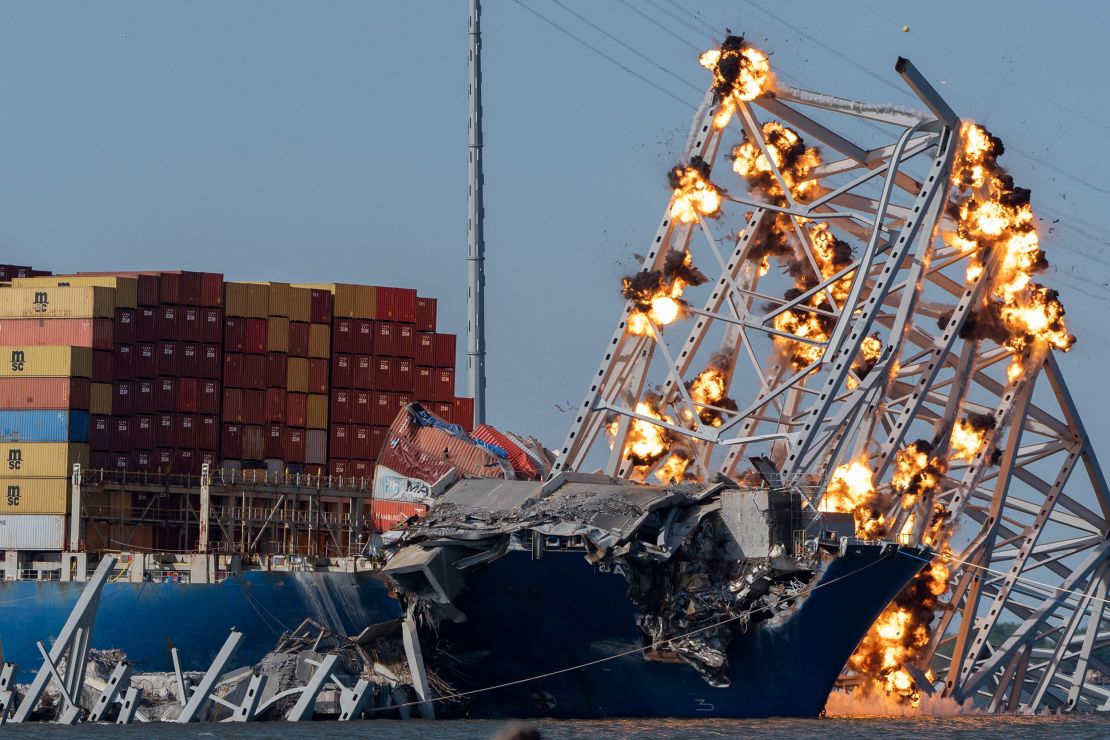
Baltimore Plans Explosive Demolition for Collapsed Bridge
The task force working on the restoration of full access to the port of Baltimore is going explosive.
Yesterday, the Key Bridge Response 2024 Unified Command announced it would be using explosive charges to deal with the section of the collapsed Francis Scott Key Bridge that landed on the containership Dali when it collided with the bridge on 26 March.
Four temporary navigation channels were opened to allow ships marooned at the port to leave and others to enter. The first box ship to come in, the MSC Cargo Passion III, reached the port through a temporary 35ft channel on 28 April, carrying nearly 1,000 containers.
At the end of April, the port said a permanent 700ft wide, 50ft deep channel would open by the end of this month and identified tomorrow as the target date to remove the truss of the bridge that had fallen onto the Dali and refloat the vessel.
And the US Army Corps of Engineers has set its sights re-opening of the main ship channel by the end of the month.
The Unified Command – comprising several state authorities, the US Army Corps of Engineers, the US Coast Guard and Synergy Marine – announced yesterday it would be using multiple explosive charges for ‘precision cutting’ of the collapsed section of the bridge.
This method has been used before, such as the controlled demolition of the Harry W Nice Memorial Bridge in Maryland in March 2023. The small charges will split the large section of truss into various smaller sections. Placing the explosives will take several days.
Thus, operators are beginning to plan the resumption of activities at the port. On Tuesday, Charles van der Steene, president of Maersk North America, said: “Our network team would expect to make final decision on the rerouting of vessels back to the port of Baltimore in the next five to ten days.”
Resumption of service could come by the end of this month, he added.
Meanwhile, analysts at the eeSea liner database have quantified exactly how much traffic the port as lost since the incident.
Destine Özuygur, head of operations and forecasting, said: “Baltimore has understandably seen a slew of vessel omissions in the past several weeks, losing 58 port calls and 315,000 teu worth of nominal capacity since the accident. The port is likely to lose an additional 31 calls and 181,000 teu of capacity in May.
“Most carriers have communicated that they will begin accepting cargo to USBAL out of Asia at the end of May. These advisories are corroborated by voyage ETAs observed in the long-term service schedules,” she added.
eeSea said the 2M’s Med-east coast North America loop 5 would drop Baltimore calls until the end of May and its North Europe-east coast North America loop 2 until late June, “although some conflicting reports from MSC show calls resuming on 22 May”, it added.
On Maersk’s standalone Amex service, vessels are omitting Baltimore until late May. Ms Özuygur noted: “The Maersk Vallvik was reported to be returning on 5 May, but has since omitted USBAL from the short-term schedule. The next vessel expected to call will be Nelle Maersk, with a current ETA of 13 June.”
The Ocean Alliance has announced its AWE5 would omit Baltimore calls through the end of June, while con-ro operator Grimaldi is also set to omit the port from its NAWAS service until mid-to-late May.
Baltimore handled about 52m tonnes of cargo last year and is the largest port for car traffic in the US, with nearly 850,000 cars and light trucks moving through last year.
Meanwhile, the Department of Transportation of Maryland is setting its sights on replacing the collapsed bridge, a major traffic artery. It estimates that the project, which will cost an estimated $1.7bn-$1.9bn, could be completed by autumn 2028.
Source: Article






